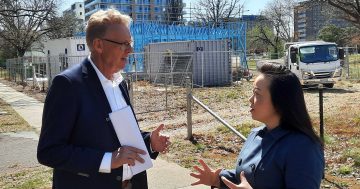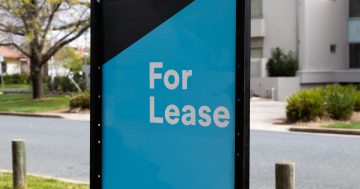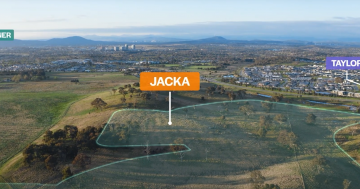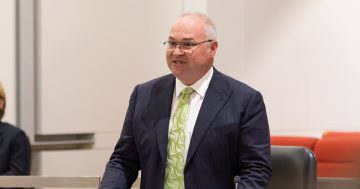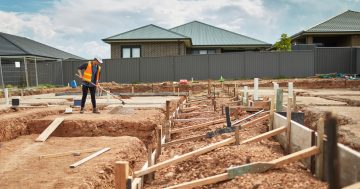
Opposition housing spokesperson Mark Parton says the government must support rental market and community housing providers. Photo: Ian Bushnell.
ACT Government policies had created a perfect storm for the housing market that was pushing more people out of private rental accommodation into an already overwhelmed public housing sector, Opposition housing spokesperson Mark Parton said.
He was commenting on the latest figures from the Productivity Commission that show little headway in the ACT’s public housing problems despite the government’s renewal program.
The Report on Government Services says the number of ACT public housing dwellings, 10,744 at 30 June 2022, is the lowest since 2013.
There were 3059 on the waiting list, with people facing anywhere between nine to 18 months before being able to get into a property.
There was also an 89-day average turnaround for vacant stock, the second highest in the nation after the Northern Territory.
Canberra has been in the throes of a rental crisis for years, with tenants paying the highest rents in the country in a brutal market in which competition can be white hot for reasonable accommodation.
Many low to medium income people are barely hanging on in the private market and others are knocking on the door of public housing but facing long waiting times.
Mr Parton said the turnaround and vacancy rates were concerning but the number of public housing dwellings also continued to fall despite government rhetoric about its renewal program.
“When I talked to the Minister about this, she says this is just point in time data. Well, that point in time seems to have lasted for about seven years now and it just goes on and they continually say that the numbers will increase soon and they’re not,” he said.
“We also saw some figures that indicate that families are really struggling to get into public housing, that’s no great surprise when you consider the number of three and four bedroom houses that the government has either sold off or bulldozed and replaced with apartments and townhouses.”
Mr Parton said the situation was all of the government’s making.
“Everything that the Liberals said would happen in this space is happening and the ROGs data for here in the ACT is genuinely reflective of what’s going on on the ground,” he said.
“And it is reflective of a government failure in this space, that what we’re seeing here is a combination of Labor Green policies that have combined to create a perfect storm in housing unaffordability and a rental crisis.”
Mr Parton pointed to the government’s land supply approach, its rates and charges, changes to the residential tenancies legislation and the absence of community housing providers in the mix.
“They’re not releasing enough land for detached dwellings which drives the price up of every form of dwelling,” he said.
“We’re talking about the spiraling rates and land tax regime. We’re talking about the continual changes to Residential Tenancies legislation, which is forcing investors out of the market narrowing that rental market, and we’re also talking about this government’s inability or its lack of will to genuinely have community housing providers as a bigger solution to the problem.”
Mr Parton said the latest proposed changes to the Residential Tenancies Act, designed to improve energy efficiency in rental properties and reduce bills, which the government said was looking after renters, would do the opposite.
“It will drive more investors out of that market,” he said. “It will further narrow that private rental market, and it will create more homelessness.”
Mr Parton was not yet ready to reveal how the Canberra Liberals would fix the problem but indicated that community housing providers would be part of the solution, as well as policies to expand the private market.
“I’m not going to announce a comprehensive housing policy today, but I can guarantee you that under a Canberra Liberals government rents will go down and we will provide hundreds more small social and affordable dwellings than the current government,” he said.
He said the government must do what it could to make the private rental market function effectively.
“But there also has to be a heavier reliance on community housing providers because the assistance that we need in this space is immediate,” he said.
The community sector said the ACT Government’s approach was failing and called on it and and the Commonwealth to take urgent action.
In a joint statement, ACTCOSS and ACT Shelter urged both governments to do more to boost the supply of social housing and for the Commonwealth to increase income supports, including a doubling of Commonwealth Rent Assistance.
“The ACT Government must take immediate action to empower our community housing providers to build more homes through access to financial support and affordable land, so that all Canberrans have a safe and secure home, no matter their income,” ACTCOSS Interim CEO Dr Gemma Killen said.
An ACT Government spokesperson said the government was acting to meet the demand for public housing across the Territory by renewing 1000 properties and growing the portfolio by at least 400 homes by 2024-25.
The spokesperson said the number of people on the waiting list for public housing had continued to grow over the past year as in most due to the impact of COVID-19 and ongoing cost of living pressures.
The government is planning for an increase of around 30,000 dwellings in the Territory with more public housing, more social housing, more affordable rental properties, more urban infill developments and more greenfield developments.
It was also encouraging investors to build more rental properties to increase the supply in the years to come.












